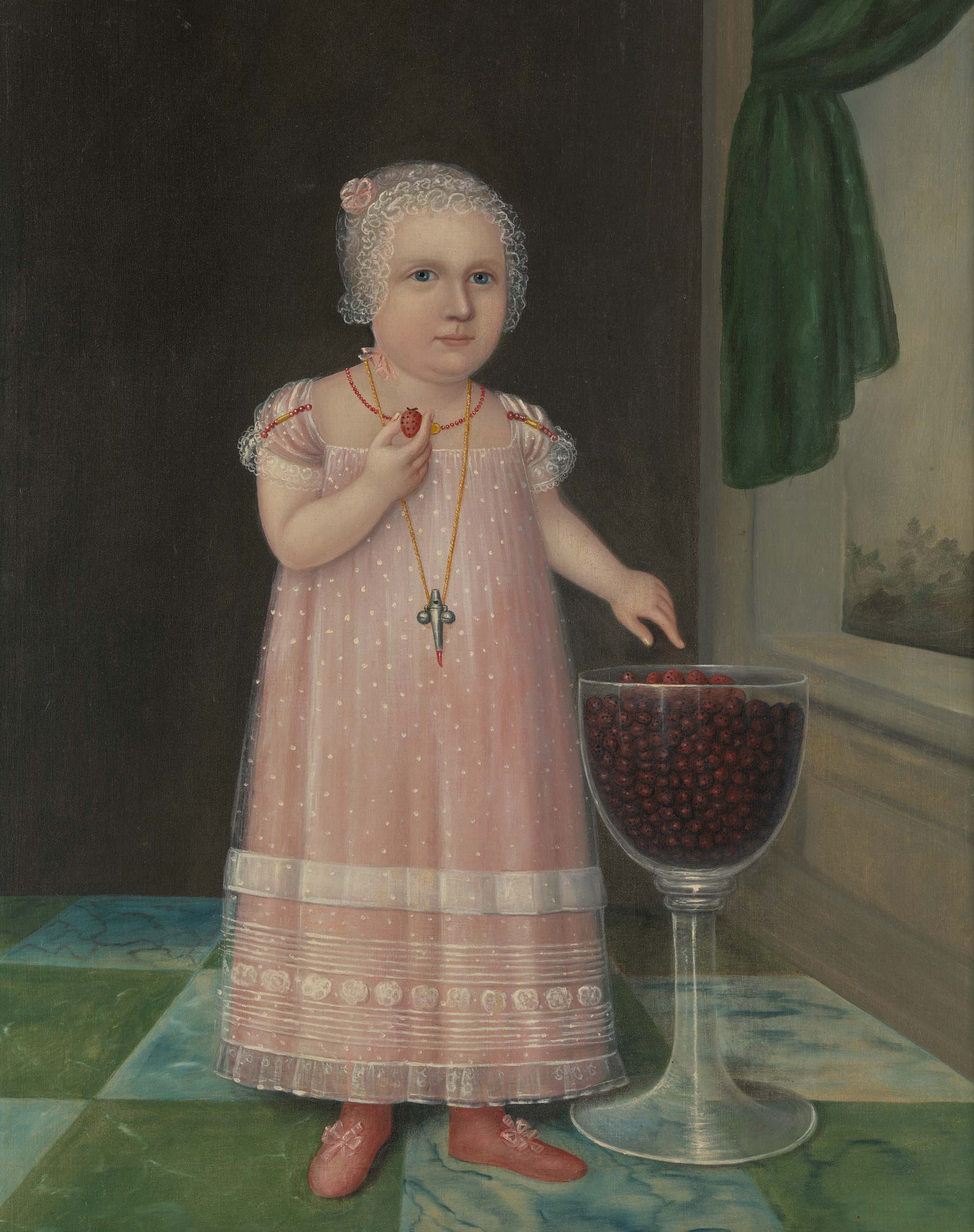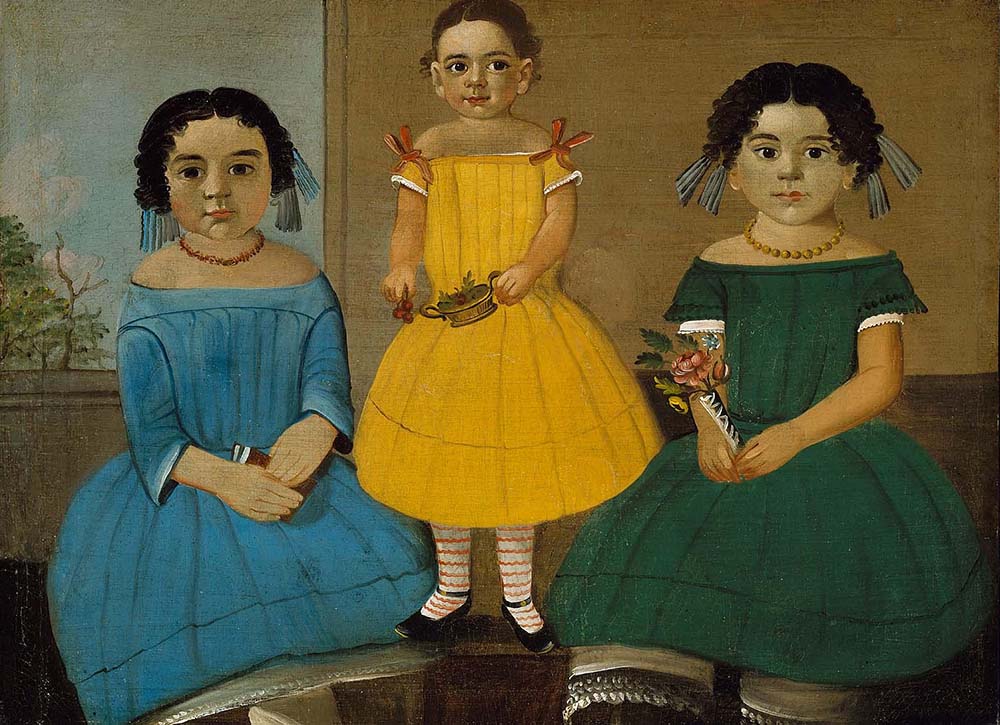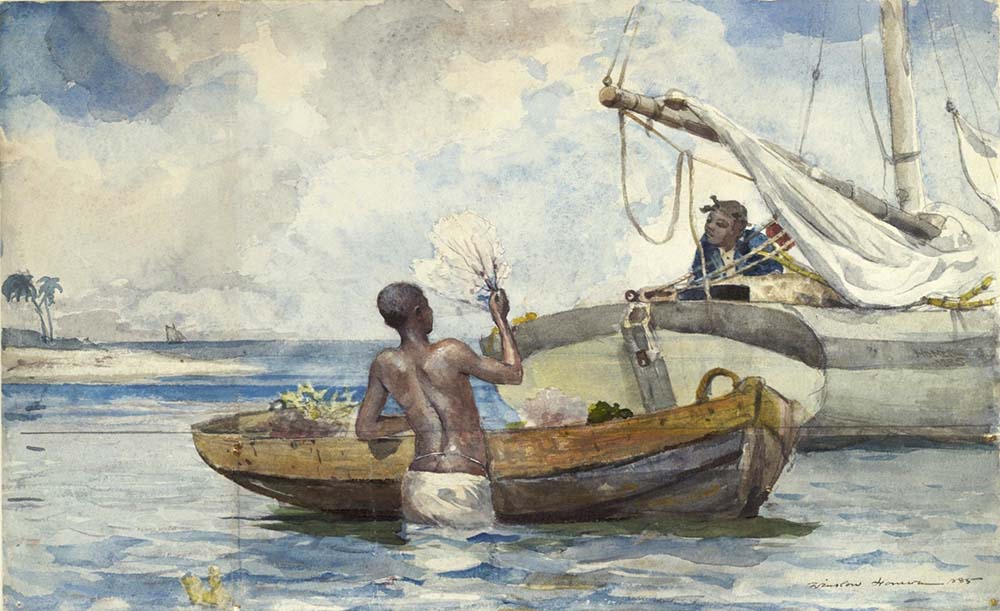
Emma Van Name, by Joshua Johnson, c. 1805. The Metropolitan Museum of Art, purchase, Nancy Dunn Revocable Trust Gift, 2016.
Early American portrait painter Joshua Johnson depicted Emma Van Name of Baltimore thoroughly ornamented in coral. The child wears a necklace of red coral beads, matching coral bar pins at each shoulder, and a silver “coral and bells”—toy, teething device, and talisman—on a long gold chain around her neck. Coral appears in a relatively high proportion of portraits by Johnson, an icon of American folk portraiture and the earliest known professional Black portrait painter working in the early U.S. Born in the West Indies and active in Baltimore between the 1790s and 1820s, Johnson painted local clients and their families, who were mostly abolitionists.
Interest in coral ornaments was not confined to any particular political ideology, geography, race, or class in the early republic. Portraits by American painters as various as Thomas Sully, Clarissa Peters Russell, Charles Willson Peale, George Caleb Bingham, and others feature white women and children from all regions of the U.S. bedecked in coral. And in William Matthew Prior’s portrait of the children of African American real estate investor Samuel Copeland of Massachusetts, one of Copeland’s daughters wears a coral necklace.

Those persons who appeared less frequently in the period’s portraiture also wore coral. Travel narratives, novels, letters, and other texts establish that coral jewelry belonged to free Black persons of various classes and to enslaved Black persons who sometimes received coral as a gift from the master’s family. The relative affordability of such jewelry also made it accessible to less privileged white families. Coral ornaments came in many forms in addition to necklaces and bracelets, including pins, earrings, rings, and tiaras, and in multiple styles, from the smooth, round beads of Johnson’s portrait to the fringed and angular pieces in Prior’s portrait. Almost all these ornaments were made of precious red coral, Corallium rubrum in Latin. Very few were merely ornamental in meaning.
One important reason so many women, white and Black, fastened coral to children’s bodies is that coral was long believed to hold talismanic and apotropaic powers, warding off a variety of maladies both physical and spiritual. These powers date to antiquity, and they persisted well into the nineteenth century, a period when infant mortality remained a tragically common occurrence, which is why coral beads remained a popular christening gift.
To many living in or passing through the nineteenth-century U.S., even the smallest piece of red coral jewelry brought to hand the labor—human and nonhuman—that produced coral. An essay in Godey’s Lady’s Book titled “Coral Reefs” (1858), for example, opens with these words: “Trusting that many of our lady readers who wear coral ornaments would like to know something of their formation, we publish the following.” The essay offers a detailed description of reef formation—drawn from European travel narratives and Darwin’s account of coral—that fashions “coral ornaments” as labor itself congealed. Each piece is literally the result of the “wonderful labors” of polyps who “die…to increase” the reef and also the product of an arduous process of human labor; the dangerous work of Mediterranean coral fishing is described in the final paragraph. And while “Coral Reefs” reached an audience of mostly “lady readers,” other genres of writing—including popular natural histories for children and Evangelical pamphlets for all—taught additional segments of the population to connect the familiar red coral jewelry circulating through daily life to the life-consuming labor of polyps and persons.

Yet the power of coral ornaments to evoke particular groups of laboring bodies, nonhuman and human, is perhaps rendered nowhere as vividly and compellingly in a single text as it is in “The Story of a Coral Bracelet” (1861) by West Indies-born British writer Sophy Moody. Published transatlantically in Moody’s collection of children’s tales, this autobiography of a red coral bead skillfully weaves together details from multiple sources of knowledge about coral’s origins and growth; its natural, cultural, and economic histories; and its journey from seafloor to parlor.
“I am not originally a denizen of earth,” for I was born “far down below the bright blue waters of the Mediterranean Sea,” begins Moody’s coral bead narrator, addressing her London audience of other “inanimate things…endowed with speech,” Christmas presents that decide to narrate their biographies to pass the time on Christmas Eve. The bead proceeds with a description of her birthplace, “the crystal depths” of “the Straits of Messina”—the narrow stretch of water between the eastern tip of Sicily and the western tip of mainland Italy—where she passed a blissful childhood, marred only by “sad stories” of “outrages” against fellow corals who were taken by “the hand of the spoiler.” Nonetheless, with “the happy forgetfulness of youth,” she hoped for “a bright future,” and the polyps constructing her body “watched with loving pride” as her “smooth limbs, so brilliantly red in color,” expanded the reef to which she belonged.
The coral was “happy, unconscious of what [its] tenth year should bring forth,” yet “the spoilers’ trade is, alas! an organized one,” and “accordingly, no sooner have we attained the perfection of our beauty, than our wretched parents know they will lose us forever.” The coral then shudders at recalling the arrival of men in boats who tore her from her reef home, placed her aboard a ship laden with other corals, and took her to a faraway port. There, corals from all over the world are “carried on shore,” sorted by size, and subjected to “new pains and sufferings,” their bodies “tortured” into jewelry and other objects that “suit the caprice of man,” for in this world our “value principally depends on our color.”
Upon her painful transformation into a bracelet, the coral passed “quickly from one trader’s hands to another” before reaching a London shop where she was recently sold as a Christmas present. “I know not what my future destiny will be,” she laments.
By telling the history of that trade from the perspective of the coral, Moody simultaneously illuminates a very different, yet connected, global route of labor that coral powerfully evoked: the transatlantic slave trade, in which Mediterranean red coral also played an important role.
It cannot escape the reader that the coral narrates her story in the form of a slave narrative, beginning with the genre’s most conventional opening, a description of the narrator’s birthplace. The coral’s personal history then closely follows that of a Black woman kidnapped from Africa and forced into slavery in the Americas: she is stolen from her home by “cruel” traders who arrive in boats, valued for beauty and color alone, subjected to physical torture, packed aboard a ship, taken on an oceanic voyage, and transformed into a commodity for sale. Furthermore, these experiences have given the bead a keen understanding of slavery’s particular peril for Black girls, which she describes in words that startlingly echo those of Harriet Jacobs in Incidents in the Life of a Slave Girl (1861), published during the same year as Moody’s tale. Just as Jacobs explains of the “female slave” that “before she is twelve years old” her “beauty…will prove her greatest curse,” the bead laments that “no sooner have we attained the perfection of our beauty”—around age ten—“than our wretched parents know they will lose us forever” to “the spoilers’ trade.”
Excerpted from Coral Lives: Literature, Labor, and the Making of America by Michele Currie Navakas. Copyright © 2023 by Princeton University Press. Reprinted by permission. Select text was originally published in “Antebellum Coral,” American Literature, Volume 91, No. 2, June 2019, Duke University Press.
